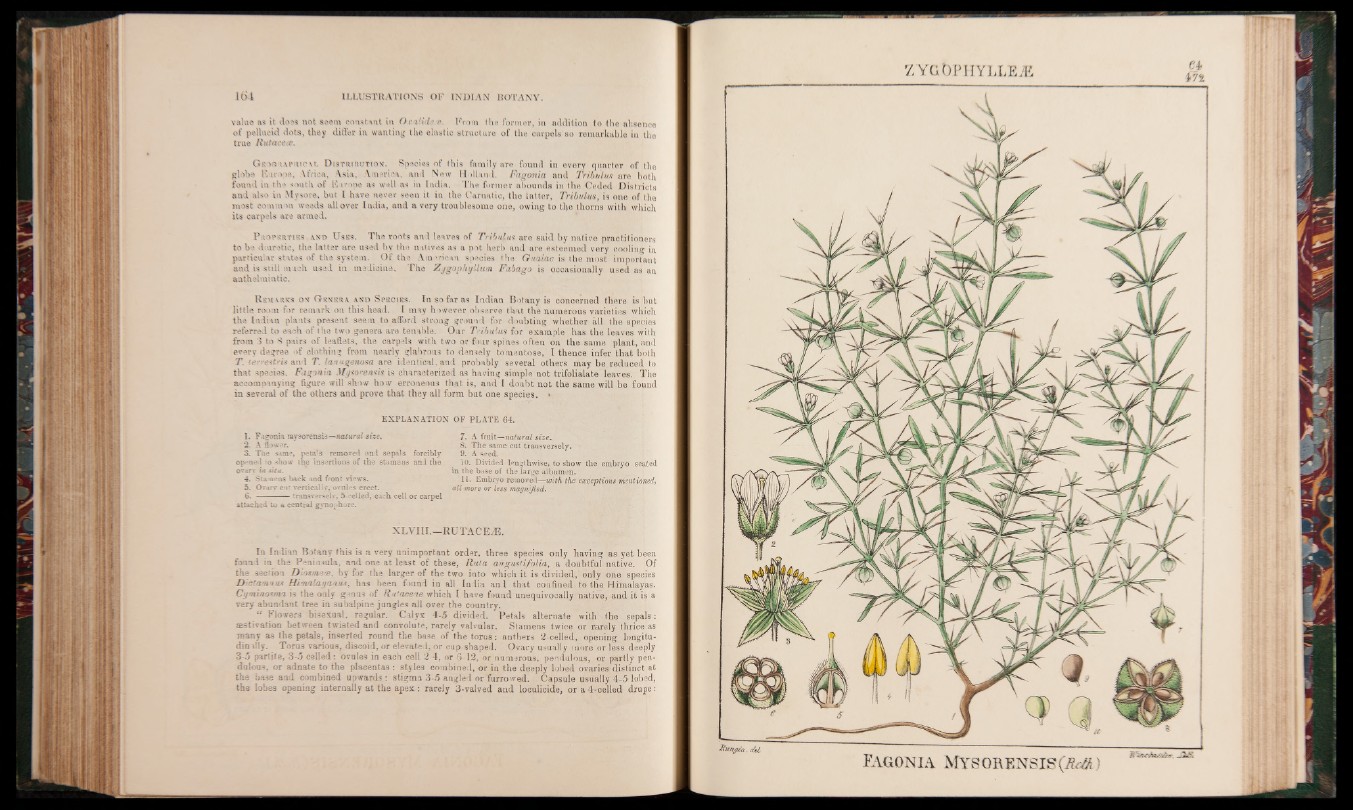
value as it does nut seem constant in O.mlidd'Q. From the former, in addition to the absence
of pellucid dots, they differ in wanting the elastic structure of the carpels so remarkable in the
true MuMgq&s
G eographical Distribution. Species of this family are found in every quarter of the
globe Europe, Africa, Asia, .America, and New Holland. Fagonia and Tribulus are both
found in the south of Europe as well as in India. The former abounds in the Ceded Districts
and also in Mysore, but l have never seen it in the Carnatic, the latter, Tribulus, is one of the
most common weeds all over India, and a very troublesome one, owing to the thorns with which
its carpels are armed.
P roperties and U ses. The roots and leaves of TribtUus are said by native practitioners
to be diuretic, the latter are used by the natives as a pot herb and are esteemed very cooling in
particular states of the system. Of the Am wioan species the Gttaiac is the most important
and is still much used in medicine. The ZjgophyUmn Fabago is occasionally used as an
anthelmintic.
R emarks on G enera and S pecies. In so far as Indian Botany is concerned there is but
little room for remark on this head. 1 may however observe that the numerous varieties which
the Indian plants present seem to afford strong ground for doubting whether all the species
referred to each of the two genera are tenable. Oar Tribulus for example has the leaves with
from 3 to 8 pairs of leaflets, the carpels with two or four spines often on the same plant, and
every degree of clothing from nearly glabrous to densely to men to se, I thence infer that both
T. terrestris and T. laimgenom are identical, and probably several others may be reduced to
that species. Fagonia Mysorensis is characterized as having simple not trifolialate leaves. The
accompanying figure will show how erroneous that is, and I doubt not the same will be found
in several of the others and prove that they all form but one species. *
EXPLANATION OF PLATE 64.
1. Fagonia mysorensis—natural size.
2. A flower.
3. The same, petals removed and sepals forcibly
opened to show the insertions of the stamens and the
ovary in situ.
4. Stamens back and front views.
5. Ovary cut vertically, ovules erect.
6. -------------transversely, 5-celled, each cell or carpel
attached to a central gmophore.
7. A fruit—n a tu ra l s i z e .
S. The same cut transversely. •
9. A seed.
10. Divided lengthwise, to show the embryo seated
in the base of the large albumen.
11. Embryo removed—with the exceptions mentioned,
all more or less magnified.
XLVIII.—RUTACEdE.
In Indian Botany this is a very unimportant order, three species only having as yet been
found in the Peninsula, and one at least of these, Rata angustifolia, a doubtful native. Of
the section Diosrma, by for the larger of the two into which it is divided, only one species
Bmiammcs Himalayan,m, has been found in all India and that confined to the Himalayas.
Cyminosma is the only genus of Rutaceae which I have found unequivocally native, and it is a
very abundant tree in subalpine jungles all over the country.
Flowers bisexual, regular. Calyx 4-5 divided. Petals alternate with the sepals :
aestivation between twisted and convolute, rarely valvular. Stamens twice or rarely thrice as
many as the petals, inserted round the base of the torus: anthers 2 -celled, opening longitudinally.
Torus various, discoid, or elevated, or cup-shaped. Ovary usually more or less deeply
3-5 partite, 3-5 celled: ovules in each cell 2 4, or 6 12, or numerous, pendulous, or partly pen-
dalong, or adnate to the placentas: styles combined, or in the deeply lobed ovaries distinct at
the base and combined upwards : stigma 3-5 angled or furrowed. Capsule usually 4-5 lobed,
the lobes opening internally at the apex: rarely 3-valved and loculicide, or a 4-celled drupe:
/ iY ( n II Yi
Fa g o n ia My s o r e n s i s ( M )